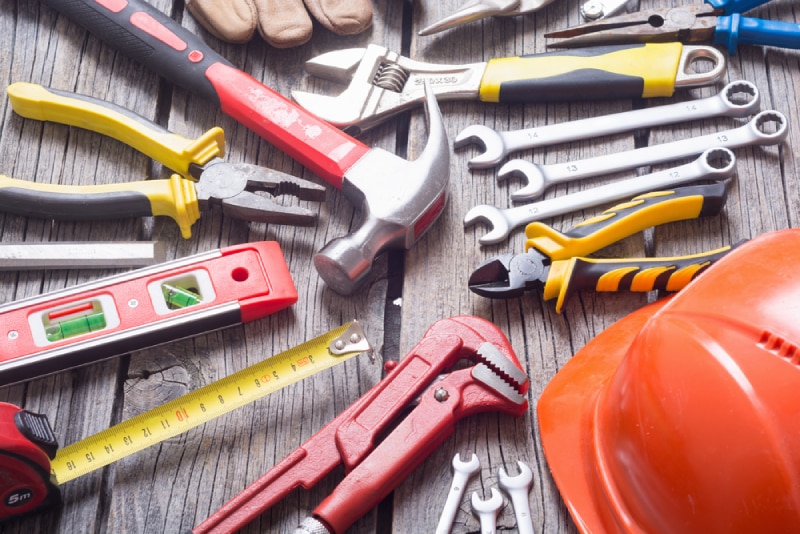10 Truck Toolbox Organization Ideas (With Pictures)
-
Adam Mann
- Last updated:

You already have your work truck and all the tools you need; now all you need to do is figure out how to organize everything! We understand what a big project this can be, and that’s why we highlighted some great organization ideas for you to check out below. If you follow these tips, you’ll have your dream work truck put together in no time, leaving you with more time to complete each job!

The 10 Truck Toolbox Organization Ideas
1. Use Layers
Vertical space is your best friend when you’re trying to organize the tools in your truck, but this means you need to figure out how to use it. Shelves are a great choice, and if you’re using them, we recommend roller shelves so you can more easily access the tools. Find ways to layer tools while still being able to access each layer and you should be able to fit in all the tools you need!
2. Ditch Factory Boxes
When you get a new tool, it often comes in its own box. It can be tempting to want to keep all the tools in the boxes they come with, but these cases take up lots of extra space. When you’re trying to fit your tools into your truck and organize them, every square inch matters. Those factory boxes take up far too much space, so they need to go!
3. Section Things Off
Part of organizing the tools in your truck is knowing where everything is and being able to get to it when you need it. When you section things into categories, you know where everything is and can quickly get the tools when you’re ready to use them.
Come up with clear sections where you group similar tools together, then find a specific spot for each tool in each section. Once you do this, you’ve mastered your truck toolbox organization!
4. Install Racks
When you are trying to make the most out of every inch of your truck, racks are a genius option. They utilize vertical space, and when you put them on roller wheels, it is easier to access each one of them. The more racks you can install, the better.
5. Utilize Foam
If you’ve ever seen a well-put-together toolbox, you’ve likely noticed they all have one thing in common: foam. Foam gives each tool a place to settle in, and it keeps them from moving around all over the place while you’re driving around. Get some high-quality foam on order and then start cutting it to the right dimensions to fit your truck.
6. Stow the Little Stuff
You don’t need to find a foam cutout for each and every small tool you have. There’s nothing wrong with getting a few high-quality bags and grouping some of the smaller tools together. Putting these small tools in a bag or something similar opens up more space for the larger tools, making it easy to move them all together at the job site.
Just be sure to keep similar tools together. That way, you’re not trying to figure out what’s where when you need them.
7. Use Magnets
Tools tend to shift around while you’re driving, and one of the best ways you can help keep them in place is with magnets. A couple of well-placed magnets can help keep your tools in place while your truck is moving, meaning you don’t need to go searching through a pile of mixed-up items when you open your toolbox.
8. Use Bags
Bags are a great way to group similar tools together and store them in your truck without taking up as much space. Not only that but putting some of your tools in bags makes it easier to take them to various areas on the job site.
Find some high-quality bags and group similar tools together. Not only does this make it easier to move them around when you need to, but it also opens up more space for you to use.
9. Keep Your Tools Clean
While this isn’t an organizational method all on its own, it makes a big difference. Simply wiping down your tools after you use them goes a long way in keeping them clean, and this will help keep the rest of your truck clean too. Sometimes, it can be quite a hassle, but it is well worth it when you have clean tools and a clean truck to use every day.
10. Ensure You Can Reach Everything
Does it really matter if you have all the tools in your truck if you can’t get to them? The last thing you want is to need to move tons of tools to reach the one you want. When you’re in a hurry you won’t put them all back the way they should go, and that’s creating more work for yourself.
When you’re planning it all out, ensure you can easily reach all your tools; otherwise, everything is going to end up a mess no matter your intentions.

Conclusion
Now that you have some great ideas on how to organize the toolbox in your truck, all that’s left is for you to put everything together! You don’t need to follow all the tips on our list, but the more you can stick with, the better-looking your truck toolbox will be in the end!
Featured Image Credit: AlexeiLogvinovich, Shutterstock
Contents
